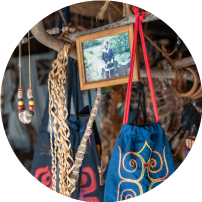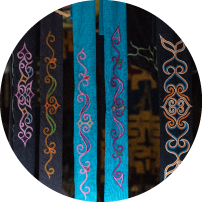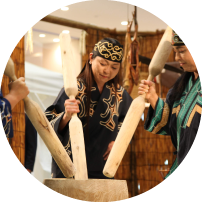- Contents
Grandma's pattern, my mother's pattern, and my pattern all in one.
The slope of Ainu Kotan are lined with souvenir stores. At the walkway in front of the store are several cats whose heads are petted by the passing tourists. Whenever I came back from school, my mother was always working with her hands while sitting in front of the store.
"I guess I was about 17 or 18 years old when I started to be interested in embroidery. Looking at the embroidery made by my mother, I thought it was pretty."
It was not easy to start by mimicking her mother's embroidery.
The stitching eyes were never well aligned, and she was unable to draw a good pattern.
"In any case, I remember just watching and learning. And since I couldn't write a pattern, my mother wrote it in the beginning and I just embroidered it...I just figured that in order to be good, I just had to go through the numbers." Her mother was constantly embroidering. Either at the store or even at the waiting room of the stage where she was an Ainu dancer.

She says that by always closely watching her mother's embroidery, she gained her own skills in embroidery.
There is a way of writing your own patterns by learning from your mother's handwork.
"Grandma's pattern, my mother's pattern, and my pattern. I imagine these as a single thing when I make this. I also make new patterns by combining it with old-fashioned patterns. I guess the base of the patterns are from the many kimonos of my grandma, my mother, and my father have at home. " She says she creates by combining parts from various kimono patterns, and in the case of custom orders, she creates her work while imagining who the orderer is. "Because every person has a different color and pattern that they match with, I guess I create by talking about that person and imagining what I think would match them. I like old-fashioned patterns but also traditional ones...or in other words, I create something new out of what I learned from my grandma and my mother." She creates original works that she learned and inherited while observing her grandmother and mother.
"Chijiri," an embroidery handed down from family
In Ainu embroidery, there is the "Ruunpe," which cuts thin white or colored cloth into the cotton fabric, the "Kaparamipu," which has a large white cloth cut into the fabric, and the "Chijiri," which directly embroiders into the colored fabric.
These will vary, depending on the region and time. Erika-san's embroidery are mainly centered on the "Chijiri." "Chijiri goes hand in hand with the Ainu of Doutou. It is because most of the kimonos of my grandma and my mothers have Chijiri. My mother inherited from her grandmother and kept it protected. I think that if I inherit it and combine it into one, I can make a good art piece. And although I like old-fashioned use of color in general, there are so many different types of people. So I try not to put too much emphasis on that." In the present, there are so many color variations of embroidery threads. You can find embroidery threads of different colors, with only subtle differences in comparison.
In the present, there are so many color variations of embroidery threads. You can find embroidery threads of different colors, with only subtle differences in comparison.
"There might only be subtle differences, but if you combine the colors I think it changes quite a lot. Sometimes you can make embroidery look like a blooming flower, just through a little combination. Although white is the standard in Ainu embroidery, even then there are differences such as pure-white and gray-white. In general, traditional embroidery uses only two colors, but there might be times where I add more color. Such as adding little points of color." Erika-san is also a mother of two children. She says she wants her daughter to learn embroidery in the same way.
Erika-san is also a mother of two children. She says she wants her daughter to learn embroidery in the same way.
"My daughter asks me to teach her embroidery, but always gets quickly uninterested. She can stitch well, but it is repetitious. After repeating this process over and over, there is a sense of accomplishment and joy when the work is completed. But I also know that this would be something an elementary school student will find a little difficult to understand. But my daughter is very good at nails and combines the colors together very well.
Oh, and take a look at this color combination. I learn something from her too." Not only are their skillful fingers passed down from generation to generation, but so are their relation to understanding color combinations. As Erika-san learned by looking closely at embroidery, so too will the traditional crafts of Ainu be passed down to her daughter."
As an Ainu dance dancer
"I love dancing. I especially love the Futtarechui. The dancing by the adults that I saw as a child were great. And of course, there is the fact that my mother danced too."
Futtarechurei is the dance of black hair, also know as the "Heartburster." It is a dance that involves the wild waving of long black hair, likened to that of a pine tree during a storm.
"I guess it's since I was about 21 years old. I never had my hair cut short. And that was because to dance the Futtarechurei. It has been about as long as my hip for a long time." She continued practicing dancing since childhood, and in addition to the Sarorunrimuse (Dance of Cranes) and the Futtarechui (Black Hair Dance) often performed in ancient dance, she learned other ceremonial dances such as the Iuta Upopo (Song with Pestle) and the Tonotokara (Sake Making Dance).
She continued practicing dancing since childhood, and in addition to the Sarorunrimuse (Dance of Cranes) and the Futtarechui (Black Hair Dance) often performed in ancient dance, she learned other ceremonial dances such as the Iuta Upopo (Song with Pestle) and the Tonotokara (Sake Making Dance).
She sometimes participates in PR events to dance, and has received numerous applause and cheers from the audience.
"I also like Hekurisarari (Obon Dance) and dance-offs. I think that the customers begin to enjoy themselves too when they watch me enjoy dancing the Hekurisarari. And it's fun to dance together with the customers during the dance-off." Currently, she teaches dance to local elementary school students.
Currently, she teaches dance to local elementary school students.
From the 3rd grade of elementary school, students learn dancing 5 to 6 times every year as a class and have a performance at the end.
"Everyone works hard. And I'm also happy that they say it's fun too. The Fox Dance is especially hard and everyone's exhausted, but they say they enjoy it. I think it is very good to dance with everyone. And it's also nice that they interact with the Ainu culture."


